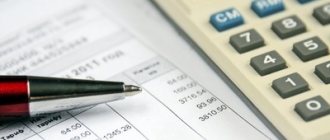Counting details
Rent is a payment that consists of the amount for the maintenance and repair of housing, social rent, as well as the cost of consuming utilities.
Size depends on:
- tariff;
- living space area;
- number of residents;
- area of common property;
- presence or absence of meters.
To determine how rent is calculated in a communal apartment, you need to find out two main components of the payment. These include individual consumption and general household needs.
If meters are installed in the premises, then compensation for the difference between total and individual consumption is made based on the area of the housing in relation to the total square meters.
There are some features of calculating payments for basic utility resources:
- When calculating heating, two calculation options can be used. In the first case, residents make payments only during the heating season. Then the area of the apartment and the tariff are taken into account. If payment is made throughout the year, then the average consumption rate is determined, and the housing area and tariff are also taken into account.
- Gas consumption is calculated based on the presence or absence of a meter in the house. If it is available, then the calculation is made by multiplying the meter readings by the tariff. In the absence of a metering device, the area of the premises, standards for heating, cooking, hot water, the number of residents and the tariff established at the regional level are taken into account.
- You can calculate the amount of hot and cold water consumption and electricity supply by multiplying the number of people living, the standard and the tariff. This calculation is used if there are no metering devices. If there is a meter, then the tariff is multiplied by its readings.
- A similar calculation system is performed in the case of apartment-by-apartment sewerage. The meter readings are taken as the values of the hot and cold water meter, which are summed up and then multiplied by the tariff. If there are none, then the standard is distributed according to the number of people living.
Not long ago, legislators introduced the concept of “home needs.” They are necessary to maintain the normal condition of not the apartment, but the entire building as a whole.
It is necessary to calculate the amount of money for each resident based on the readings of communal meters. The value is distributed among residents depending on the area of their apartment.
If there are no meters in houses, then the total amount of resources consumed is multiplied by the tariff.
The price for housing maintenance and repairs should be determined by apartment owners at a general meeting during the functioning of the HOA. During this process, needs are considered, as well as the amount of payment. If the work is carried out by a management company, then it can independently determine the amount based on a contract agreement with the companies providing the service.
Collective meters must be installed by all houses in accordance with the legislation of the Russian Federation, and installation is carried out by resource supply organizations, however, not all companies strive to follow this norm and shirk their responsibilities
How to pay if no agreement is reached
If the owners and tenants of residential premises in a communal apartment could not come to a mutual agreement, then payment for utilities must be made in accordance with the Housing Code in the following order:
Payment for heating will be carried out in proportion to the shares in the total area.
Payment for water supply and gas will be carried out in accordance with the number of people living in the room, in particular persons under the age of majority, and those who live as guests for more than one month.
Payment for electricity will be carried out in accordance with the power of lighting devices and their number in each room.
Payment for space in a communal apartment will consist of payment for living space and payment for an area proportional to it in common areas.
Also, it is possible to distribute utility bills by installing individual metering devices, separating the personal account for payment for utility services and payments for the use of common communal property.
What does the outcome depend on?
The amount of utility bills may vary depending on several factors. First of all, the value is influenced by the number of people living and registered in the apartment. The more of them there are, the more expensive the communal apartment will be.
It refers to:
- supply of cold and hot water, gas (if metering devices are not installed);
- supply of electrical energy (in the absence of meters);
- removal of household waste;
- sewerage.
But there are some values that will remain unchanged. Payment for repairs and maintenance of housing, as well as heating, is considered fixed.
As a result, owners refuse to register unauthorized persons into their apartments. After all, the cost of utility bills increases several times. And there is no documentary evidence of the obligations of registered persons to pay the bill. Therefore, responsibility lies entirely with the owner.
Today, the most convenient way to pay rent is to use online Internet services.
How you can pay rent through the government services website, read the article at this link.
Private practicing lawyer Victoria Suvorova (Pyatigorsk) answers:
If you do not have meters installed, then water charges are calculated according to the standard. Otherwise, if, for example, you go somewhere and do not use water, you need to write an application to the management company so that you will not be charged for the use of water for this period. If you did not write such a statement, then you will be charged water consumption according to the standard, based on one person registered in the apartment.
How to stop paying utility bills in an empty apartment?
5 phrases that kill the desire to call the housing department (but you still have to)
What are the rules for calculating rent in a communal apartment?
The amounts that the tenant will need to pay are compiled on the basis of certain documentation. This includes contracts concluded with resource suppliers.
If housing is rented, payment is made depending on the terms of the contract. This takes into account the number of square meters occupied in the living space.
Low-income people who rent housing do not have to pay for its use.
Payment for owners of residential premises is determined on the basis of regulations of the HOA or housing department. The amount varies depending on the estimate of income and expenses for maintaining the home prepared over the past year.
All owners must pay the same amount on the receipt. The payment document specifies the amount of payment and the person's debt.
The procedure for calculating the amount of payment for utilities provided in a communal apartment
Comments
The procedure for calculating the amount of payment for utility services for consumers living in a room (rooms) in a residential building that is a communal apartment (hereinafter referred to as a communal apartment) is determined by paragraph 50 of the Rules approved by Decree of the Government of the Russian Federation dated May 6, 2011 No. 354 (hereinafter referred to as - Rules).
For consumers living in a communal apartment, the amount of payment for utility services is determined based on the number of citizens living in such a room (rooms), readings from metering devices installed in the rooms and apartment for cold, hot water supply, electricity, gas supply, or based on residential the area of the room occupied by the consumer in a communal apartment for heating services.
The calculation of the amount of payment for utilities provided for general house needs is determined based on the living space occupied by the consumer of the room in the communal apartment .
If a communal apartment is equipped with a common (apartment) electricity meter, and all rooms of such an apartment also have indoor electricity meters , the amount of payment for electricity is determined based on the readings of the common (apartment) meter and the readings of the room meter .
The amount of electricity that was used to illuminate common areas in a communal apartment is distributed according to the number of people living in the rooms of the communal apartment .
If a communal apartment is equipped with a common (apartment) metering device , but not all rooms are equipped with room metering devices for electricity supply , the amount of payment is determined based on the readings of the general (apartment) metering device, room metering devices, as well as on the basis of the conditions specified in the contract between consumers in a communal apartment a written agreement to pay for electricity consumed for lighting common areas in a communal apartment , which is the common property of the owners of rooms in a communal apartment.
The specified agreement is concluded and executed in writing, signed by consumers or their authorized representatives, transferred to the utility service provider, who calculates the amount of payment for electricity supply in accordance with the agreement , starting from the month following the month in which this agreement was transferred to the contractor.
In the absence of such an agreement, the readings of room metering devices are not taken into account when calculating the amount of payment for electricity supply , and the calculation is made based on the readings of the common (apartment) metering device and the number of persons living in the rooms of a communal apartment .
It should be noted that if the residential premises are a communal apartment and are not equipped with a common (apartment) metering device for cold, hot water supply (except for the case of establishing two-component tariffs for hot water), electricity supply, if there is an obligation to install such metering devices , when calculating the amount of the fee a multiplying factor of 1.5 is applied .
For consumers living in residential premises of corridor, hotel and sectional type dormitories ( if there are common kitchens, toilets or shower blocks on the floors ), the calculation of the amount of payment for utility services is determined according to the methods specified in the Rules for consumers living in communal apartments .
For consumers living in residential premises of apartment-type dormitories , the amount of payment for cold and hot water supply, sewerage, electricity supply, heating, gas supply, and solid municipal waste management is calculated according to the methods defined by the Rules for consumers living in the residential premises of an apartment building .
Read in the same category:
- Unauthorized connection to in-house engineering systems
- The procedure for calculating the amount of payment for utilities provided in a communal apartment
- Installment payment for utilities
- Recalculation of the amount of payment for utilities in the temporary absence of a consumer in a residential premises
- The procedure for calculating the amount of payment for utilities in an apartment building
Previous post Unauthorized connection to in-house engineering systems
Next entry Recalculation of the amount of payment for utility services in the event of a temporary absence of a consumer in a residential premises
Established amounts
Each person can independently calculate how much he needs to pay for rent. To do this, you will need to find out the number of square meters of occupied residential premises and the services provided by housing and communal services.
In addition, the calculation may take into account:
- presence or absence of an elevator;
- lighting inside the entrance;
- the presence of light outside in the yard.
The receipt also contains the amount for payment according to the indicators of the gas, water and electric meter. They are multiplied by the number of persons who are registered in the residential premises.
In addition, there are amounts that cannot be calculated according to metering devices. In this case, a standard tariff is determined, which is multiplied by the number of people living.
The established amounts and payment process can be changed by the residents of the house. To do this, you need to create an HOA (homeowners' association).
At the general meeting they determine the amount of payments for:
- cleaning the area inside the house and in the yard;
- carrying out major and current repairs of the house;
- replacement of heating, power supply and drainage systems;
- repair of gas equipment;
- elevator operation;
- removal of solid waste.
It is worth knowing that indicators may vary depending on certain conditions.
The area of the apartment depends on:
- housing stock management;
- maintenance, repair and maintenance of common property;
- monitoring the condition of engineering property inside the house.
The larger the owner’s apartment, the more expensive the services for elevator maintenance, garbage removal, and major repairs will be.
If the apartment does not have metering devices, then payment for the use of water, gas, sewerage and electricity will be determined according to the number of residents
It is worth remembering that the payment should not include the costs of purchase and replacement:
- glass;
- doors;
- lighting lamps.
These costs are already included in the repair and maintenance of housing.









